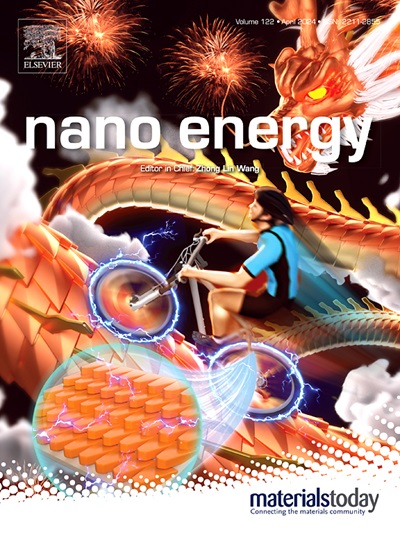Exploring Li pathways in Si-C/Gr electrodes and their SEI in Li batteries using Li isotope tracing by MAS-NMR and FIB-SIMS
IF 16.8
1区 材料科学
Q1 CHEMISTRY, PHYSICAL
引用次数: 0
Abstract
One promising way for enhancing Li-ion battery performance is the use of silicon-graphite-composite anodes. Even though this complex system has been extensively studied, the lithium dynamics in silicon/graphite-composite electrode material, as well as at the interfaces, is still not well understood. To investigate lithium mobility and trapping effects in the solid electrolyte interphase (SEI) during lithiation and at rest state in Si-C/Gr composites, we use here a methodology based on combined MAS NMR and FIB-SIMS, both sensitive to lithium isotopic labeling. Labeling electrolyte and Li metal counter electrode with 6Li, and SEI with 7Li allows distinguishing the origin of lithium ions within graphite and silicon active materials. Following electrochemical lithiation, the SEI shows the lowest 7Li fraction while it is higher in both Si and graphite, providing a direct observation of the so-called knock-off mechanism for the movement of lithium ions through the SEI. However, the lower 7Li fraction of silicides points out that another mechanism of Li transport, possibly through vehicular mechanism (solvated or desolvated Li), is also at play, enabling a more direct transfer of lithium ions from the electrolyte to silicon particles. In addition, in Open Circuit Voltage (OCV) experiments, Li movement seem to be different in Li-rich and Li-poor silicides, as the Li-rich phase exchanges faster with 6Li enriched electrolyte. The innovative 6/7Li isotope tracing approach described here paves the way for further understanding of the transport properties between electrodes and electrolyte, controlling these phenomena and developing knowledge for the development of high-performance battery technology.

利用Li同位素示踪(MAS-NMR和FIB-SIMS)探索Li在Li电池中Si-C/Gr电极及其SEI中的路径
提高锂离子电池性能的一个有希望的方法是使用硅-石墨复合阳极。尽管这个复杂的系统已经被广泛研究,但锂在硅/石墨复合电极材料中的动力学,以及在界面上的动力学,仍然没有得到很好的理解。为了研究Si-C/Gr复合材料在锂化过程和静止状态下固体电解质界面(SEI)中锂的迁移率和捕获效应,我们在这里使用了一种基于MAS NMR和FIB-SIMS的联合方法,这两种方法都对锂同位素标记敏感。用6Li标记电解质和锂金属对电极,用7Li标记SEI,可以区分石墨和硅活性材料中锂离子的来源。电化学锂化后,SEI显示出最低的7Li分数,而Si和石墨中的7Li分数都较高,这为锂离子通过SEI的运动提供了所谓的敲除机制的直接观察。然而,硅化物中较低的7Li分数表明,锂离子的另一种传输机制,可能是通过载体机制(溶剂化或脱溶),也在起作用,使锂离子从电解质更直接地转移到硅颗粒。此外,在开路电压(OCV)实验中,富锂和贫锂硅化物中Li的运动似乎有所不同,因为富锂相与富6Li电解质交换更快。本文描述的创新的6/7Li同位素示踪方法为进一步了解电极和电解质之间的输运性质,控制这些现象以及为高性能电池技术的发展提供知识铺平了道路。
本文章由计算机程序翻译,如有差异,请以英文原文为准。
求助全文
约1分钟内获得全文
求助全文
来源期刊

Nano Energy
CHEMISTRY, PHYSICAL-NANOSCIENCE & NANOTECHNOLOGY
CiteScore
30.30
自引率
7.40%
发文量
1207
审稿时长
23 days
期刊介绍:
Nano Energy is a multidisciplinary, rapid-publication forum of original peer-reviewed contributions on the science and engineering of nanomaterials and nanodevices used in all forms of energy harvesting, conversion, storage, utilization and policy. Through its mixture of articles, reviews, communications, research news, and information on key developments, Nano Energy provides a comprehensive coverage of this exciting and dynamic field which joins nanoscience and nanotechnology with energy science. The journal is relevant to all those who are interested in nanomaterials solutions to the energy problem.
Nano Energy publishes original experimental and theoretical research on all aspects of energy-related research which utilizes nanomaterials and nanotechnology. Manuscripts of four types are considered: review articles which inform readers of the latest research and advances in energy science; rapid communications which feature exciting research breakthroughs in the field; full-length articles which report comprehensive research developments; and news and opinions which comment on topical issues or express views on the developments in related fields.
 求助内容:
求助内容: 应助结果提醒方式:
应助结果提醒方式:


